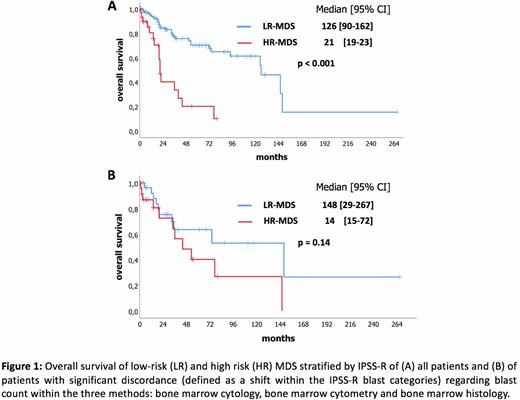Abstract
Introduction: Risk stratification is an essential step after diagnosing a myelodysplastic syndrome (MDS). It defines patient prognosis and guides therapeutic decisions (ranging from "watch and wait", best supportive care to hypomethylating agents and allogeneic stem cell transplantation). In the Revised International Prognostic Scoring System (IPSS-R), the percentage of marrow blasts (inferred via cytology) plays a pivotal role in addition to karyotype, hemoglobin level, platelet count and absolute neutrophil count. However, blast quantification in MDS is subject to inter-observer and inter-modality variance. In the recently published Molecular IPSS (IPSS-M), the variable blasts had a small weight compared to some molecular aberrations. Blast count can be performed with three different methods: bone marrow cytology (BM-c), BM flow cytometry (BM-f) and BM histology (BM-h).
The aims of this retrospective study were to analyze the differences of blast evaluation among the three methods BM-c, BM-f and BM-h and what impact these differences have on categorizing patients according to IPSS-R and overall survival (OS).
Methods/Results: Since 2012, we prospectively annotated comprehensive clinical, laboratory and bone marrow data of newly diagnosed MDS. In this study, we included 214 cases of MDS (median age 71 years, male/female: 142/72) with blast enumeration performed via BM-c, BM-f and/or BM-h. In 178/214 (83%) cases, precise blast counts were available in at least two methods (mostly BM-c and BM-f).
Overall, discordance (defined as a shift within the IPSS-R blast categories) regarding blast counts were detected in 79/178 (44%). In 57/88 (65%) of cases, blast counts were concordant within all three methods. In cases with blast enumeration available in two methods (BM-c and BM-f, only), blast counts were similar in 26/48 (54%) cases, only. Interestingly, within the cases with blast count discordance (and availability of BM-c), patients had either a) no change (19/58, 33%), b) a down-grade (25/58, 43%) or c), an upgrade (14/58, 24%) of IPSS-R category when BM-f or BM-h were applied instead of BM-c.
Furthermore, a possible shift of the IPSS-R category in individual cases led to re-stratification from low-risk MDS (LR-MDS, IPSS-R very low, low, intermediate) to high-risk MDS (HR-MDS, IPSS-R high, very high) in 3/39 (8%) and viceversa in 8/39 (21%), respectively. In the cohort of patients with blast count discordance (n=58), the IPSS-R failed to stratify between LR- and HR-MDS regarding OS (Figure 1b) in contrast to the cohort of all patients (Figure 1a).
Conclusion: In this study, we could demonstrate that, a) significant discordance regarding blast count was detected in about 50% of patients,
b) discordant blast count led to significant shifts (down or upgrade) within the IPSS-R categories (which may have high impact on treatment decisions), c) in the cohort with blast discordance the IPSS-R failed to stratify between LR- and HR-MDS, and d) blast enumeration is clearly highly vulnerable and its value on risk-stratification should be down-graded which is the case in the new IPSS-M.
Disclosures
Nowak:Celgene: Honoraria; Sumitomo Dainippon Pharma Co. Ltd: Research Funding; AbbVie: Other: Investigator funded clinical trial; Affimed GmbH: Research Funding; Takeda: Honoraria; Pharmaxis Ltd.: Current equity holder in private company, Research Funding; Apogenix: Research Funding.
Author notes
Asterisk with author names denotes non-ASH members.


This feature is available to Subscribers Only
Sign In or Create an Account Close Modal